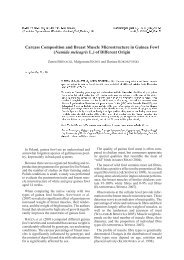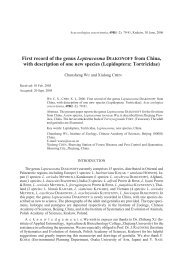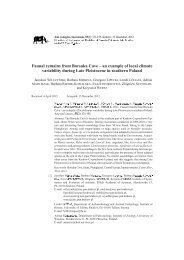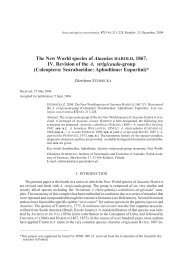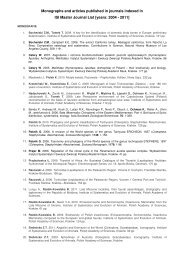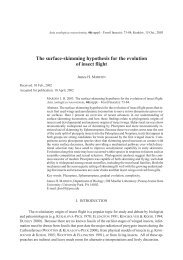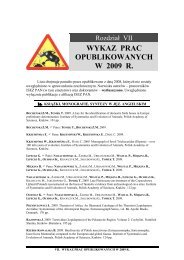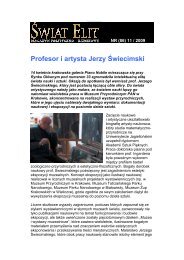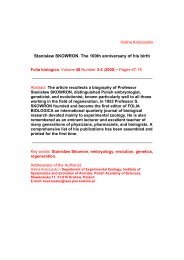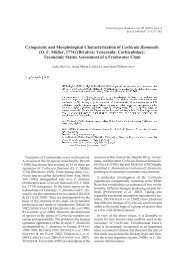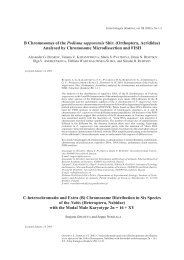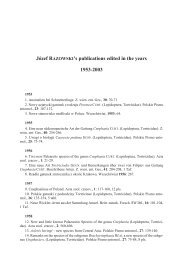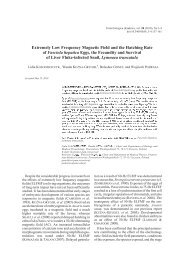Rafael Gioia MARTINS-NETO, Oscar Florencio GALLEGO
Rafael Gioia MARTINS-NETO, Oscar Florencio GALLEGO
Rafael Gioia MARTINS-NETO, Oscar Florencio GALLEGO
Create successful ePaper yourself
Turn your PDF publications into a flip-book with our unique Google optimized e-Paper software.
Triassic insect fauna from South America<br />
251<br />
new information on this and other Gondwanan faunas (e.g., recent studies on Triassic faunas from<br />
Australia; P. JONES, pers. comm., 2001), might modify these conclusions.<br />
Six of the seven conchostracan families recorded from the Triassic of Argentina show close relationships<br />
with faunas from Laurasia and Gondwana. The families Palaeolimnadiopseidae (genus<br />
Endolimnadiopsis SHEN, 1994), Pemphilimnadiopseidae, Ulugkemiidae, Loxomegaglyptidae and<br />
Fushunograptidae (genus Liograpta <strong>GALLEGO</strong> &COVACEVICH 1998) recorded in the Triassic of<br />
Argentina have Devonian to Cretaceous representatives in Laurasia. In particular, Palaeolimnadiopseidae<br />
is documented by the genus Endolimnadiopsis, also recorded from the Upper Permian of<br />
Russia. Challaolimnadiopsis SHEN & <strong>GALLEGO</strong>, 2001 belongs to Pemphilimnadiopseidae, a family<br />
recorded from the Upper Devonian of China, Upper Carboniferous of North America, and the Upper<br />
Permian-Lower Triassic of Germany, Italy, Russia, China and Africa (SHEN et al. 2001). Ulugkemiidae<br />
are represented by the genus Triassulugkemia <strong>GALLEGO</strong>, 1999, which is also recorded<br />
from Middle Devonian and Upper Permian of Russia (<strong>GALLEGO</strong> &MELCHOR 2000). The Loxomegaglyptidae<br />
(documented in Argentina and the south of Brazil by the genus Triasoglypta <strong>GALLEGO</strong>,<br />
1999) have representatives from the Carboniferous to the Tertiary of Laurasia, Lower Carboniferous<br />
of England, Permian through Triassic of Russia, Triassic through Tertiary of China, and Triassic<br />
and Tertiary of South America. The Fushunograptidae (documented in Argentina and Chile by<br />
the genus Liograpta) was recorded in Russia (Upper Permian and Jurassic), Korea (Triassic), China<br />
(Triassic and Jurassic), Europe (Upper Triassic and Jurassic), and Africa (Triassic). The abovementioned<br />
evidence, along with the record from the Triassic of Argentina allows for the suggestion<br />
that it is highly probable that members of these families migrated from Asia either via India to Africa<br />
and South America or via India to Antarctica and South America through the southern point of<br />
Patagonia.<br />
The oldest records of Eosestheriidae are from the Triassic of Argentina and Chile (documented<br />
by the genus Menucoestheria <strong>GALLEGO</strong> &COVACEVICH, 1998). Prior to these findings its biochron<br />
was restricted to the Middle Jurassic to Lower Cretaceous of Asia, Europe and Antarctica. SHEN<br />
(1994) described the genus Carapacestheria (Eosestheriidae) from the Ferrar Group (Middle Jurassic<br />
of Victoria Land, Antarctica) and also noted that some of the characters of this genus are also<br />
present in specimens from the Middle Jurassic of Argentina, namely Cyzicus (Lioestheria) patagoniensis<br />
TASCH 1970 (Cañadón Asfalto Formation, Chubut Province) and in Cyzicus (Lioestheria)<br />
malacaraensis TASCH 1970 (La Matilde Formation, Santa Cruz Province). Cyzicus (Euestheria)<br />
taschi VALLATI and Cyzicus (Euestheria) sp. 1 (also from the Cañadón Asfalto Formation, Chubut)<br />
described by VALLATI (1986) might be added to this list of related forms, also belonging to<br />
Eosestheriidae. VALLATI (1986) already mentioned the similarities between Cyzicus (Euestheria)<br />
sp. 1 and Yanjiestheria xiaxiaensis WANG (Eosestheriidae), the last described from the Upper<br />
Jurassic-Lower Cretaceous of China. These new records of this family allow a hypothesis on its dispersal<br />
from Argentina or the southernmost end of South America through Antarctica to Asia and<br />
Europe (see Fig. 7).<br />
The family Polycytellidae (Glosselytrodea) has been restricted until now to the Upper Triassic.<br />
They are very rare; only 6 species are now known in the geological record. These include: Mesojurina<br />
sogjutensis MARTYNOVA (1952), Mongolojurina altaica PONOMARENKO (1988) and<br />
Karatajurina unica VILESOV & NOVOKSHONOV 1994, from the Russian Upper Triassic,<br />
Polycytella triassica TILLYARD 1922, and Permoberothella perplexa RIEK 1974, both from the Upper<br />
Triassic of Australia, and Argentinoglosselytrina pulchella <strong>MARTINS</strong>-<strong>NETO</strong> &<strong>GALLEGO</strong> 2001,<br />
from the Upper Triassic of Argentina. The paleogeographic distribution of the group is presented in<br />
Fig. 7. Although containing a relatively small number of well-known species, this is an important<br />
record, as Polycytellidae make excellent index-fossils, being restricted to the Upper Triassic, and<br />
with an exclusively Gondwanan distribution. In paleobiogeographic terms, this group possesses<br />
wide distribution within Gondwana, with records in Argentina, Australia and in the South Asia. It is<br />
very probable that Polycytellidae could be found in Antarctica in the future.



